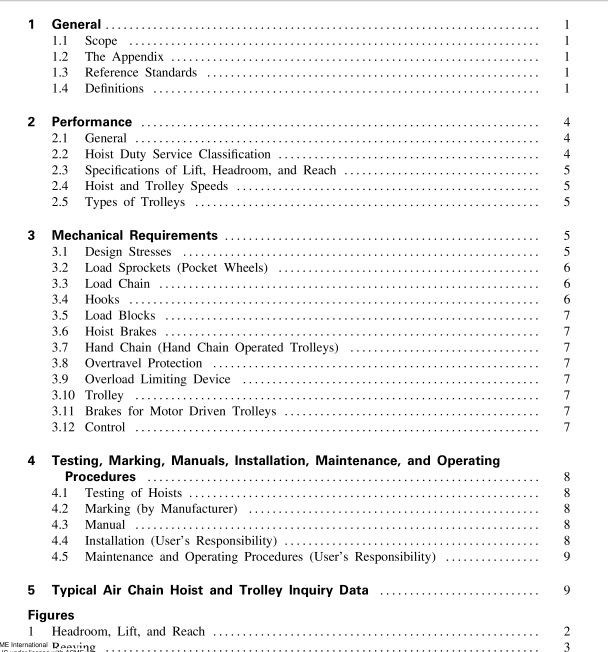ASME HST-5:1999 pdf free download PERFORMANCE STANDARD FOR AIR CHAIN HOISTS
2.2.2 Hazardous Locations. When hoists are used in hazardous locations as defined by ANSI/NFPA 70 or other special codes, modifications or additional pre- cautions not covered by this Standard may be required. In these locations, only hoists designed in a manner suitable for the conditions encountered shall be used.
2.2.3 Duty Classification. While all the factors listed in para. 2.2.1 must be considered in selecting the proper class of hoist, most industrial applications can be generalized according to the percentage of rated load normally handled and the running time. Listed in Table 1 are the two duty classes that have been established for air powered chain hoists. The majority of hoist applications will fall into the A4 category.
2.3 Specifications of Lift, Headroom, and Reach 2.3.1 Lift. Most air chain hoists are manufactured with standard lifts of 10 ft, 15 ft, and 20 ft (3.3 m, 4.9 m, and 6.6 m). One of these standard lifts will normally be adequate for the particular requirement. It is recommended that the purchaser specify the required 2.3.2 Headroom. Headroom should be specified ifimportant to the application.
2.3.3 Reach. Reach should be specified if importantto the application.
2.4 Hoist and Trolley Speeds
Hoisting equipment is available over a wide rangeof hoist and trolley speeds.Listed in Table 2 are typicalspeed ranges commonly available.
2.5 Types of Trolleys
Hoist trolleys are available in plain,hand chainoperated, and motor driven types. Selection of eachtype depends upon the application.
2.5.1 Plain Type. This type is recommended wheretrolley motion is infrequent or relatively short. Due tothe required force to manually operate this type oftrolley,it is also recommended that the use of plaintrolleys be limited to a maximum load of 3 tons or3,000 kg with the elevation of the beam not more than20 ft (6 m) above the operator’s floor level.
2.5.2 Hand Chain Operated. This type is recom-mended where trolley motion is relatively infrequentor short and for those loads and beam heights wherea plain-type trolley would be impractical. The handchain operated trolley provides good load spottingability obtained by pulling on the hand chain,which isconnected to trolley wheels through gears or sprockets.
2.5.3 Motor Operated. This type is recommendedwhere the operating frequency , distance of travel, or thetype of load being handled would cause unsatisfactoryoperation if the trolley were the plain or hand chainoperated type. Design of motor operated trolleys shallbe based on operation on a straight beam,unlessotherwise specified. Where trolley travel involves acurved beam, beam switches,or execptionally longruns, special design may be required, and full particularsshould be provided with the inquiry.
3 MECHANICAL REQUIREMENTS3.1 Design Stresses
(a) The hoist and the means of suspension suppliedwith the hoist shall be designed to withstand all stressesimposed under normal operating conditions while han-dling loads within the rated load.
(b) Load suspension parts shall be designed so that the static stress calculated for the rated load shall not exceed 20% of the average ultimate material strength. Elements specially provided to give a visible warning of severe overload by structural deformation shall be designed so that the static stress calculated for the rated load shall not exceed 35% of the average ultimate strength.
(c) Power transmission parts shall be designed so that the dynamic stresses calculated for the rated load shall not exceed the fatigue and endurance limit estab- lished by the manufacturer.
(d) Modifications to upgrade or rerate hoist equipment shall be as authorized only by the original equip- ment manufacturer. If it is impossible or impractical to contact the manufacturer, the work shall be authorized by a qualified person. After such modifications are made, the hoist shall be tested in accordance with ASME B30.16.
ASME HST-5:1999 pdf free download
